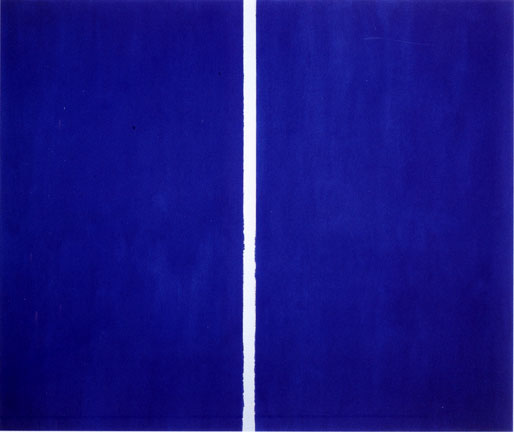Last Updated on March 12, 2024 by Masha Eretnova
Have you ever stumbled upon an old painting in your house or attended an art auction, wondering if the artwork you’re looking at holds any significant value?
I’d like to address a few key factors that determine the worth of a painting.
Whether you’re a seasoned art collector, a curious beginner in the art world, or someone who unexpectedly found or inherited an intriguing painting (tucked away somewhere in a garage, we all know where all things go…), I’m sure my simple guide will help you.
Table of Contents
This article contains affiliate links. It means no extra cost for you but a little commission (2-3%) for me to support my hobby and blog. Thank you!
The 2 highest-valued original paintings are Willem de Kooning’s Interchange sold for $300 million in 2015 and Salvator Mundi by Leonardo da Vinci sold for $450.3 million in 2015.
Factors That Tell If A Painting Is Valuable
The most important factors are artist reputation, art style, condition of the work and the frame and the authenticity of the work.
But there are many more key things to know to make sure it is not only original but valuable work.
Artist’s Reputation
The reputation and fame of the artist significantly influence a painting’s value.
Paintings by renowned artists and established artists (those with a long list of awards, solo exhibitions and publications) tend to be more valuable than those by lesser-known or emerging artists.
If artist had shows, participated in exhibitions or even is part of a permanent exhibition in a gallery or museum, it increases the value.

Provenance of the valuable paintings
A documented history, especially if it has been part of significant collections or exhibitions, can increase the value of a painting.
If the painting made part of a collection of someone famous, it will cost more than if it was just in some private collections.
Any rumors, drama and stories related to the previous owner can also affect the price. As they say even a black PR is a good PR.
One of the examples are works sold from the Rockefeller collection in 2018 at Christies.
It is said that just because the previous owner was Rockefeller, the value of the works was 20% to 30% higher, which resulted in Monet’s Waterlilies from his collection being sold for whooping $84.6m.
Subject Matter and Theme
Paintings depicting popular or historically significant subjects, such as iconic landscapes, historical events, or famous people of the time period, may have higher value due to their appeal to a broader audience.
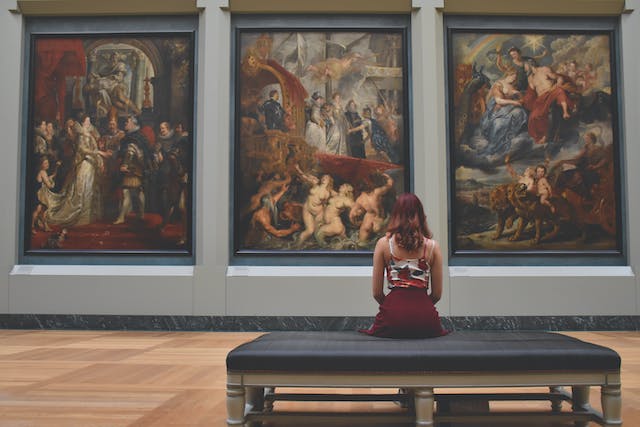
Expert appraisers say that portraits of beautiful women as well as bright and colorful landscapes were sold for more money.
Yet, if the name of the artist is famous enough or the person/place on the painting is famous, the style or color scheme will matter less.
Subject can also matter depending on the time period we live in.
Today, activist painting, abstract art, modern art is very popular and we may be overlooking some realistic landscapes.
In 17th century, the same way, Caravaggio’s Death of a Virgin was rejected at the time for the name for certain, but it is now in Louvre.
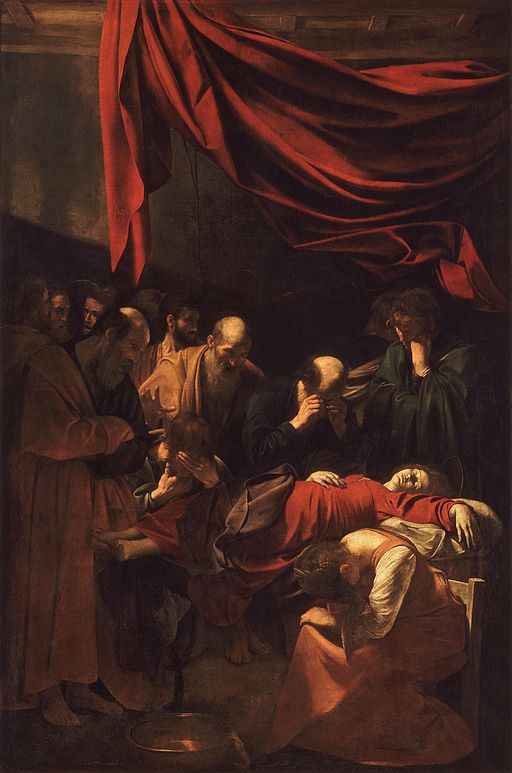
Artistic Style and Technique
The uniqueness and quality of the artistic style and technique used in the painting can influence its value. Skillful execution and innovation in the artist’s approach can add value to the artwork.
Some styles are more valuable at a given time, mostly after the artists death.
Van Gogh today is one of the most famous artists of all times, but during his whole life he only sold one of his works!
El Greco was considered an opposition to traditional techniques and his works had no style name at the time.
But we know that Orchard Bordered by Cypresses (1888) by Van Gogh was sold for more than $100 million dollars in 2022.
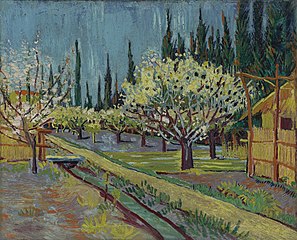
Condition and Preservation
The physical condition of the painting plays a crucial role in determining its value.
Paintings that are well-preserved and in good condition are generally more valuable paintings than those with significant damage or deterioration.
The actual painting should have been varnished (and revarnished) – as varnish tends to yellow over time, and preserved in good temperature-humidity settings and has no visible defects.
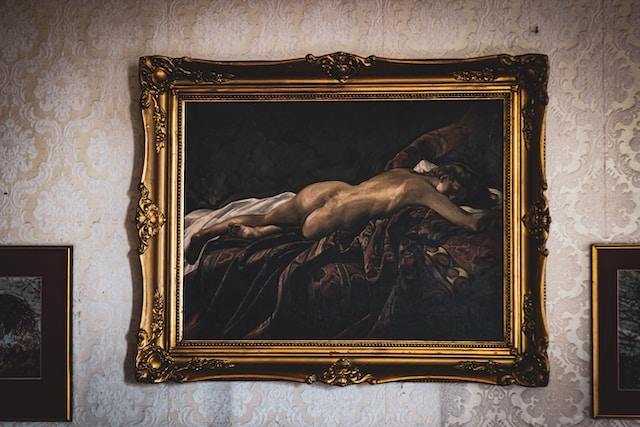
You need to take a magnifying glass and inspect the painting: any cracks, paint chipping off, missing paint etc will decrease the value.
You can also discover (most likely with help of appraisers) that the work was already restored or cannot be restored if it has any issues. That also will bring its value down.
Some experts may found out that the work was redone, or had an unknown addition and then it will be tricky to get the highest value for it.
The best way to assess the condition is to talk to a real expert.
Medium and support: oil paintings vs other mediums
Historically, oil paintings had more value and old oil paintings are still having a lot of value (as long as they are in great condition or by famous painter), but in 21st century a lot of abstract art is made with acrylic paint and it sells well.
Usually, paintings on canvases or on panels are more valuable than works on paper and photography.
Prints on paper or giclee (print on canvas) normally has lower value because it is technically only a copy of an original painting.
But if it is an original print in a smaller edition of 3 or 5 works (limited edition prints) it can have better value than regular prints.
Also note that not just any canvas painting is valuable. It should be original canvas and not a relined one as it is a sign of past damage.
A work on paper can not have any tears or defect, it is very visible and it has extremely low value.
Yet, again, unless it is something long lost and unique, and very valuable in terms of history of art.
Read also: 9 Best & Affordable Museum Quality Prints: from Van Gogh to Picasso
Size
The size and medium of the painting can also impact its value.
Larger paintings and those created with valuable or rare materials may command higher prices as they have more “wall power”.
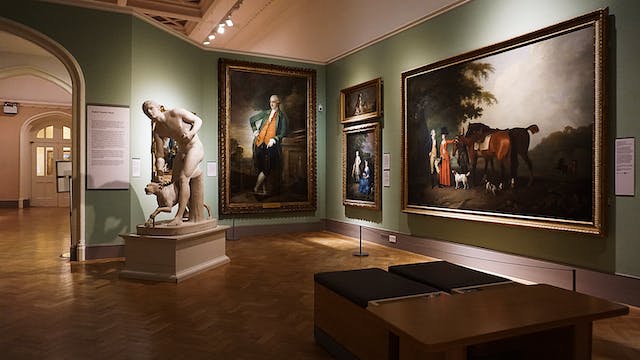
Market Demand For Fine art
Current market demand and trends in the art world can affect the value of a painting.
If there is high demand for artworks by a particular artist or of a certain style, the value may increase, if you are trying to sell a realistic seascape to an audience that mostly consumes abstract or sculpture – you won’t get the desired price.
Sales Records and Auction Results
When you will be looking into the previous ownership, a hint about the value is the real sales traction.
Looking at past sales records and auction results for similar artworks by the same artist can provide valuable insights into the painting’s potential value.
Time is definitely something that increases the value of a good painting, so if you have an idea of previous pricing (and the condition is still good) you are likely to be able to get a higher appraisal.
But sometimes there is no traction at all. If it is a rarity that was held in private collection you can expect to have higher value.
Authenticity
Original and authentic work will always have the highest value. Fakes and copies won’t have much value at all, unless it is something the buyer is going for.
Again, inspect the painting with a magnifying glass:
- you must be able to see the texture of the canvas or paper, or even brushstrokes or paint waves, especially if it is a key characteristic of the painter’s style.
- if you noticed dots and a grid, it is most likely a print, a reproduction.
- check that signature matches other works by that artist and the certificate of authenticity (if it is still available)
- if the surface is absolutely flat and smooth, it is also just a print (evenif it is on canvas).
- if the edges of the canvas paintings are too clean and the painting has very sharp borders, it may be also a print or a fake painting.
- authentic painting will have signs of ageing, texture, bumps, brush strokes, layer of matte or gloss varnish.

Frame
A frame is actually something that can visibly increase the value of the painting, especially if it is an original wooden frame from the time it was painted.
19th century frame will be more valuable that modern restored frame.
Unique, carved, colored, massive, rare wood frames and high quality frames will also be extremely valuable.
As usual, under the condition that it is still in a good state.
For ex., record-sale Salvator Mundi’s, the frame actually added the value a lot.
It is a black and gold design from 16th century, that was covered with another frame, and eventually restored for a lot of money.
Some other frames can be extremely expensive like a frame with 10,000 diamonds created by well known artist Debbie Wingham.
Colors
Surprisingly, some colors tend to have more and higher sales, for ex., red and blue.
A painting called Blood Red Mirror by Gerard Richter sold for $1.1 million – it is practically just red-tinted canvas, and Concetto spaziale, Attese by Lucio Fontano was sold for $1.5 million. While blue-dominated work – Barnett Newman’s Onement VI – was auctioned for $43.8 million.
Back of the canvas
It is vital to check back of the canvas to make sure the painting is real but it can also reveal some details and increase the value.
Sometimes the signature will be only at the back and the name of the artists can increase the value by dozen of thousands of dollars (the case of The Garden by Mary Louise Fairchild MacMonnies sold for $37,500 after discovering her initials at the back).
The back of the canvas also can identify a fake.
An authentic work on canvas, especially oil painting, will absolutely have signs of ageing on the back of the canvas.
So if there is none, it is a fake, a reproduction, a copy – something of a much less value or not original at all.
Looking at the back of the canvas you can also roughly determine the time frame. Before 1900-1940s nails were used to secure the canvas on the wooden support.
So if you see empty nail holes or remaining nails, the work is original and you already now that it is from the beginning of the 20th century or earlier.
Since then – staples.
When were paintings created? Date
If possible we need to know when the work was created.
Firstly, as I mentioned, the time is the greatest multiplier of the value.
But for art experts and collector, the date will also be important because the work of a certain artist is more valuable if it is in his “best creative time period” or if it is a certain style, the date closer to the foundation of that style will also mean higher value.
It means that the early Impressionists, Cubists, Pop artist will always be more valuable than thossw who came after them.
Art appraisal expert say that probably the only exception to this rule is Pablo Picasso.
Read also: Collecting Art Books: 50+ Best Books on Art Collecting You Should Read
If It Turns Out Your Painting Is Valuable, what’s next?
1. Determine the artist and rough price estimate
First, I would use good old Google – take a photo of the painting you found and upload it to Google lens.
If it is something valuable and the artist is famous, Google will find it right away.
If there are no identical painting, don’t get discouraged just yet, it may be a rare painting, something that wasn’t photographed before. But Google will suggest you similar paintings.
Don’t close the tab and look through these paintings, note how much works similar to the one you own are worth. It may help later on.
You can also directly consult with a specialist, and better a few of them to have a rough estimate.
If you don’t want to talk to anyone yet, you can look for prices of similar works that are already sold and get an idea of how much your painting is worth:
- on Saatchi Art or Artfinder (they will be marked sold) for free – it is mostly for modern artists.
- For free on Artsy price database.
- buy the art prices index from ADEC
- Check in online database (paid subscription but has a day pass), this one is mostly for American market and this one for European.
- Website like 1stdibs.
- You can find auction records books in some libraries
Do not do your research on Instagram, etsy, facebook or ebay. Those sources may be not reliable and prices there may not be backed by any official appraisal.
2. Get an appraisal
Even if you are pretty sure of what is the range you are going for, it is still worth getting a free or a paid appraisal from an expert.
It is a pretty exemplaire story in the art world of a man from Massachusetts who bought a nice drawing on paper for $30 on a garage sale only to find out, with a help of an expert, that it may be worth $50 million.
The Smithsonian American Art Museum recommends visiting official appraisers like American Society of Appraisers, Appraisers Association of America or International Society of Appraisers but you can always go for a smaller private business or a consultant (if they have credible traction)
How can I get my painting appraised for free?
As I said you can get your art evaluated for free – during free “open house” days that the auction house in your area organises.
3. Sell or proudly keep in in your collection
- sell at an auction house (only choose those with good reputation and successful sales)
- sell through art platforms like Artsy (your best option), ARTDEX, Arteïa etc
- sell to a private collector who you can meet at galleries, art shows or online.
If you are not about money, you can always keep it as an asset or as something that is dear to your heart (if that’s the case).
FAQ
How do I know if my painting is valuable if it has no signature?
If your painting doesn’t have a signature, you can check the technique used in the painting, like the brushwork and colors as well as the style. Then google it or ask appraisers if they can help you.
I would take a picture of the painting and run it through Google Lens.
How can you tell if a painting is a original or a copy?
To find out if a painting is real or a copy, check the signature and any certificates that come with it. Real paintings are usually signed by the artist, and certificates give information about where the painting came from.
Real paintings have special details in the brushwork, texture and colors that are hard to copy exactly. Copies might look a bit different or have mistakes.
What makes a painting valuable?
Name of the artist, art style, period of creation, perfect condition of canvas and frame as well as its authenticity make a painting valuable.
How can you tell if a painting is antique?
Antique paintings often feature historical scenes or portraits from the past. Signs of age like cracks, discoloration, or fading can provide clues to its antiquity. Antique frames often made from wood or displaying intricate designs, and the back potentially has old labels or markings.
You can always ask an art appraisal or search your painting on Google.
Is there an app to identify paintings and value them?
Google Lens, Magnus, Smartify, Painter Values Check and Limna can help identify and evaluate the paintings for free.
Can Google identify a painting?
Yes, if you upload a picture of a painting to Google Lens and Goole can identify it.
But only if it was somehow uploaded online or is truly old and authentic. It may not help with identifying unknown artists or rare work that was only in private collection and had no pictures of it.
Figuring out if a painting is valuable can be an exciting adventure!
By paying attention to the artist’s reputation, examining the quality and uniqueness of the artwork, considering its history and condition, and seeking expert guidance when needed, you can gain valuable insights into its worth.
Remember, art is not just about the price; it’s about the stories, emotions, and beauty that a painting holds. And sometimes you may not want to sell it at all!
And if you see unknown artist, suspiciously uniformly smooth surface that looks like fake painting, no artist’s signature or not the original one, and you are not sure when were these paintings created – you may be looking either at a fake or at something that is not worth much.
So, whether you’re an art collector, a beginner in the art world, or stumbled upon a hidden gem in your home, I hope I helped you get a better idea of the value and meaning behind each brushstroke.
Have you ever found a painting that turned out to be very expensive? What was it?

Masha Eretnova, born in 1991, is a Buenos Aires-based certified teacher, artist, and member of the Professional Artist Association with 20+ years of personal painting journey.
She started painting and drawing very early and is now an international abstract artist and educator passionate about acrylic painting, gouache, and crafts.
Her works are part of international exhibitions and contests, including ArtlyMix (Brazil), Al-Tiba 9 (Spain), Exhibizone (Canada), Italy, and many more.
Besides her artistic pursuits, Masha holds a post-grad diploma in Teaching Film Photography and 2 music school diplomas: piano and opera singing.
